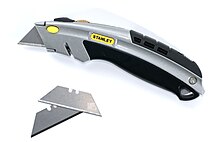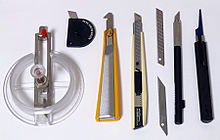Cutter (knife)
A carpet knife , wallpaper knife , box knife, cutting knife , Stanley knife , Japanese knife , or cutter (English to cut "to cut"), often incorrectly called a cutter knife in colloquial terms , is a very sharp knife that is provided with a blade that you can pull it in after use and gradually break it off after wear and finally replace it, with the shaft being available for further use.
General
This form of knife originally came from the Stanley Works company from New Britain in Connecticut , which also manufactured disposable scalpels for medical and scientific use for the first time in the early 20th century. The name goes back to the industrialist Frederick Trent Stanley , who was also the owner of the now expired patents from the 1930s.
With these knives, a distinction is made between a snap-off blade (segment blade) and an exchangeable blade. In the case of knives with exchangeable blades, the entire blade is replaced with a new one after it has worn out. These knives, regardless of whether they have a rigid blade fixation or a retractable blade on a slide, can be equipped with both trapezoidal blades for general cutting work and hooked blades for carpets. In the case of more modern snap-off blades, on the other hand, the blade has a few predetermined breaking points at which it can be broken after the front areas have been worn away, so that a rear and sharper part moves forward.
The types with exchangeable blades are used for all pending work until they no longer meet the requirements. Then a new blade is inserted into the shaft. Due to the design, many types used today are still interchangeable blades, especially when it comes to curved or shaped blade tips. Demolition blades, on the other hand, always have a linear tip shape and the front areas of them can be broken about 8 to 15 times before a new blade has to be inserted. With newer models, curved (hook-shaped) blades can also be broken off, including blades for foam.
Both types are extremely versatile and inexpensive. Due to the material properties designed for short-term use, they can be made extremely sharp, with features that would support long-term use fading into the background. They are not re-sharpened.
Because of their sharp point, they are also suitable for paper processing, where the blade point is important. The companies OLFA and NT in Japan developed "papercutter-knifes" independently of one another in 1956 and 1958, which were the first to have snap-off blades.
Cutters are also often used in model making , as they can be used universally for fine work and their sharpness can be restored without much ado. The smooth cutting of polystyrene foam (e.g. Styrofoam) is almost only possible with a cutter or a thermal saw . In particular, utility knives / cutters with segment blades are less suitable for cutting carpets. Cutters with hooked blades are more suitable here, in which the blade is fixed and can be changed through the handle opening. Depending on the manufacturer, the blades are ground with a wedge angle of 14 °.
In Europe, older craftsmen in particular initially rejected cutter knives as "disposable knives". Thanks to their good performance properties, however, they have established themselves on the market.
Alternative terms
In Israel, Switzerland and East Germany this knife is also known as the Japanese knife , in Brazil as the Estiletes or Cortadores Olfa . In Austria the designation cutting knife or Stanley knife is common , in the Netherlands Stanley mes is common, in Denmark the designation Hobbykniv (hobby knife) is common. In American English the term utility knife is common, while in British English the term Stanley knife is used.
Cutters are also known as carpet knives , but this does not correspond to the manufacturer's name, but is based on frequent use.
to form
A distinction is made between cutters with snap-off blades (also known as segment blades) and utility knives with fixed trapezoidal or hook blades. While cutters with segment blades are mostly intended for cardboard , paper , plasterboard and thinner, mostly thermoplastic plastics , the utility knife with a fixed blade can also be used to cut carpets , veneers , sacks or cables .
Snap-off blades have a round hole near the rear end, the 9 mm wide z. B. one with 3 mm diameter to positively connect the blade to the slide. This slide engages automatically in increments of the length of the segment or is fixed by a clamping lever or screw. With some knives, an extra clamping of the blade at the exit point creates a particularly play-free hold.
Snap-off blades are made from an endless steel band by grinding, punching, embossing the oblique snap-off grooves and hardening. The narrow standard blade is 9 mm wide, 0.38 mm thick and has a cutting length of 80 mm. With 12 break-off grooves, the blade can be reused 13 times. The wide standard blade is 18 mm (= nominal size, actually 19 mm = 0.75 inches ) wide, 100 mm long at the cutting edge, 0.5 mm thick and can be used 8 times thanks to 7 grooves. Break-off segments and the overall blade have a parallelogram shape, the blade is slightly longer than the cutting edge up to the inclined end. Depending on the severity of the cutting task, there are also different thicknesses for each blade width, which - for all nominal widths of 9, 12, 18, 22 and 25 mm - range from 0.25 to almost 1 mm. The blades are oiled to prevent corrosion and are stuck in a plastic box as a somewhat sticky stack. Types made of stainless steel are rarely used, as the blades are usually used up faster than annoyingly rusty.
Trapezoidal and hooked blades have one to three holes or notches on the back as clamped types. Those with two or three notches can be used in different length positions. They can usually be used by turning them 180 degrees at both ends. Wider trapezoidal blades are also used in scrapers for cleaning flat glass, for example.
Circular, rotating types are also available in special shapes for perforating thin cardboard or for creating a wave cut, but this is more likely in cutting machines. Extra small blades are only used to cut adhesive tapes that are used to seal packaging boxes made of corrugated cardboard or in circular cutters for circles. There are snap-off blades with snap-off grooves at right angles and those that provide several hooked blades one behind the other. Blades without breakaway grooves allow deep cutting into soft foam without the risk of breaking off. In the area of stronger blades, there are also those with saw teeth for wood. Specially shaped blades with differently oriented cutting edges or two-edged bevel tapering to the point are used for special tasks. Many can be inserted into standard blade holders and completely retracted into them for protection, others are merely fixed in place.
For cost reasons, the blades are usually only made of HCS steel . But there are also blades with a titanium nitride coating , which, due to their hardness , can also cut aluminum and mild steel well. Snap-off blades with HSS bimetal strips and a development with tungsten carbide strips have also been available since 2014. Blades made of manganese - silicon steels are new to the market . New developments are blade strips with HSS bimetal and blade strips with tungsten carbide.
There are also magazine knives that automatically reload a new strip of blades when the old one is used up and ejected.
Blades or parts of blades (without breaking grooves) can - with caution - be used on some punched edges as scrapers for smoothing wood or for deburring cut plastic and metal.
Risk of accident
Cutters / segment knives have a relatively high number of accidents, which can be attributed to a lack of practice on the part of the user and carelessness in handling used blades. If you work with a segment blade that is extended far out, there is a risk of breakage, and the breaking blade can injure the user. In some countries, such as Australia, these knives are classified as dangerous and can only be purchased by people over the age of 18. In some companies only knives are permitted whose blades are automatically drawn in by spring force and therefore have to be pushed out and held on a slide with the force of the thumb. There are 2 types of security diameters with automatically retracting blades, also known as automatic blade retraction: for a safety knife with CTE ( w Illens a bhängigem K lingen detail) in which the blade is pulled by spring force when the thumb is released from the slider; the other safety knife with WUK ( w Illens u nabhängigem K lingen detail) in which the blade is automatically retracted when the cutting operation is interrupted, even when the thumb is still on the slide.
Trivia
Some schools in the US are banning ownership because of a campaign against the sale of cutters to young people. This campaign was initiated in the 1990s by New York City Mayor Rudolph Giuliani .
literature
- Trade association for trade and goods logistics (BGHW): carton knife . Bonn 2012



